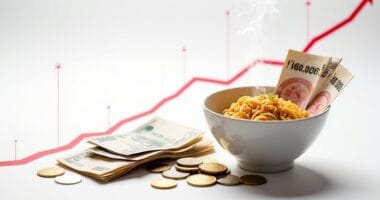Trump’s proposed tariffs are already sending economic shockwaves through American households, even before implementation or court battles. The average family faces a $3,800 hit in 2024, with lower-income families bearing the heaviest burden. Consumer goods from shoes to groceries are seeing price hikes as retailers adjust supply chains. Fun times ahead: a projected 6% GDP decline and 5% wage drop. The full impact of these economic tremors might surprise you.
While proponents of tariffs claim they protect American jobs, the harsh reality for U.S. consumers tells a different story. The numbers are brutal: American households are staring down the barrel of a $3,800 hit to their wallets in 2024, and that’s just the beginning. By 2025, Trump’s tariffs will slap families with what amounts to a $1,200 annual tax increase. Not exactly the kind of math most people were hoping for.
Let’s get real about what this means for everyday life. Those new shoes you’ve been eyeing? More expensive. Weekly groceries? Prepare to pay more. Even the basic stuff – toilet paper, cleaning supplies, your kid’s school backpack – all headed north on the price chart. The impact on clothing is particularly severe, with apparel prices rising 17% under these tariffs.
The latest economic forecasts suggest global supply chains have been severely disrupted, leading to widespread inventory shortages and delivery delays.
And if you’re thinking about fixing up your car, better start saving now. Auto parts are getting the tariff treatment too.
Here’s where it gets really ugly: these price hikes don’t hit everyone equally. Lower-income families, who already stretch every dollar, get hammered the hardest. Middle-income households aren’t escaping either – they’re looking at a staggering $22,000 loss over their lifetime. So much for economic fairness.
The ripple effects go deeper than just consumer prices. U.S. GDP could tank by 6% in the long run, and wages might drop by 5%. Companies aren’t exactly rushing to hire when they’re dealing with higher production costs and market uncertainty.
Even American manufacturers, who were supposed to benefit from all this, are struggling with pricier imported materials and retaliatory tariffs from other countries.
And here’s the kicker – even if courts block these tariffs, the damage could already be done. Retailers and manufacturers are already adjusting their prices and supply chains.
The agricultural sector‘s getting squeezed from both ends – higher costs to produce and fewer places to sell. Electronics, cars, household goods – pretty much everything in your shopping cart is caught in this economic crossfire.
Welcome to the new normal, where protecting American jobs somehow translates to emptier American wallets.





